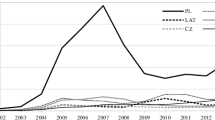Abstract
As the accession negotiations continue between the European Union and the Central and Eastern European Countries, Germany in particular fears that granting free movement of labour to these countries might generate a wave of new entrants that could overwhelm its labour market. The following article uses migration determinants and draws on previous experience of integrating countries into the EU in an attempt to reach conclusions about migration patterns that may result from the forthcoming eastward enlargement.
Similar content being viewed by others
References
Cf. Stanton S. Russell, Michael S. Teitelbaum: International Migration and International Trade, World Bank Discussion Papers No. 160, Washington D.C. 1994, p. 33; Philip L. Martin: Trade and Migration: NAFTA and Agriculture, Institute for International Economics, Washington D.C. 1993, p. 27; Philip Martin, Elizabeth Midgley: Immigration to the United States, Population Bulletin, June 1999.
For a more detailed analysis of foreign workers employed in EU countries see Melanie Kiehl, Heinz Werner: The Labour Market Situation of EU and of Third Country Nationals in the European Union, IAB-Topics, No. 32/1998 (original: Melanie Kiehl, Heinz Werner: Die Arbeitsmarktsituation von EU-Bürgern und Angehörigen von Drittstaaten, IAB-Kurzbericht No. 18, 7th Dec. 1998—both can be downloaded at http://www.iab.de); Heinz Werner: Economic Integration and Migration—The European Case, IAB-Topics No. 12/1994 (can be downloaded at http://www.iab.de).
Simone Veil (Chairperson): Report of the High Level Group on Freedom of Movement. Presented to the Commission on 18th March 1997. On the basis of this report the European Commission drew up an “Action plan for free movement of workers” Brussels, 12th Nov. 1997, COM(97) 586 fin.
Peter Robson: The Economics of International Migration, London 1987, p. 65; George Borjas: Economic Theory and International Migration, in: International Migration Review, No. 3/1989, pp. 1, 457 ff.; Willem Molle: The Economics of European Integration, Aldershot 1994, p. 205.
The data match those of Eurostat: Labour market survey 1998. For more detail, cf. Elmar Hönekopp, Melanie Kiehl: Zentral- und Osteuropäer in den Mitgliedsstaaten der Europäischen Union—Migration, Bevölkerung, Beschäftigung, in: ibv, No. 25, 23rd June 1999.
See the extensive treatment in: Alexander Tassinopoulos, Heinz Werner (1998): Mobility and migration of labour in the European Union, in: European Centre for the Development of Vocational Training: Mobility and migration of labour in the European Union and their specific implications for young people, Luxembourg 1998, pp. 5 ff.
European Commission: Broad Economic Policy Guidelines, European Economy No. 66, Brussels 1998, pp 160 f.
European Commission: First Cohesion Report, Brussels and Luxembourg 1996.
Cf. European Commission: First Cohesion Report, op. cit. Brussels and Luxembourg 1996. p. 21; and Eurostat: Regions, Statistical Yearbook, various years; or Eurostat: Statistics in Focus—Regions, No. 1, 1998.
Cf. also: “Was verdient man wo in Deutschland?” (“What do you earn where in Germany”) in: IAB-Materialien, No. 2/1999, p. 6.
See footnote 9. European Commission: First Cohesion Report, Brussels and Luxembourg 1996.
For a more detailed account see Peter A. Fischer, Reiner Martin, Thomas Straubhaar: Should I stay or should I go? In: Tomas Hammar et al. (eds.): International migration, immobility and development, Oxford, New York 1997.
For a more detailed account see A. Tassinopoulos, H. Werner, op. cit. Mobility and migration of labour in the European Union, in: European Centre for the Development of Vocational Training: Mobility and migration of labour in the European Union and their specific implications for young people, Luxembourg 1998, pp. 5 ff.
European Commission: Regular report from the Commission on progress towards accession by each of the candidate countries, composite paper, 13th October 1999 (http://europa.eu.int/comm/enlargement/report_10_99/composite/x2.htm).
European Commission: Employment in Europe, Brussels 1998: similarly also, H. Brücker, F. Franzmeyer: Europäische Union: Osterweiterung und Arbeitskräftemigration, DIW Wochenbericht 5/97, p. 93.
For greater detail see: Elmar Hönekopp: Economic and labour market development in selected reform countries in Central and Eastern Europe, in: E. Hönekopp, S. Golinowska, M. Horálek (eds.): Economic/Labour Market Development and International Migration—Czech Republic, Poland, Germany, Beiträge zur Arbeitsmarkt- und Berufsforschung (BeitrAB), 1999.
See footnote 14. Peter A. Fischer, Reiner Martin, Thomas Straubhaar: Should I stay or should I go? In: Tomas Hammar et al. (eds.): International migration, immobility and development, Oxford, New York 1997.
Author information
Authors and Affiliations
Rights and permissions
About this article
Cite this article
Hönekopp, E., Werner, H. Is the EU's labour market threatened by a wave of immigration?. Intereconomics 35, 3–8 (2000). https://doi.org/10.1007/BF02927895
Issue Date:
DOI: https://doi.org/10.1007/BF02927895



